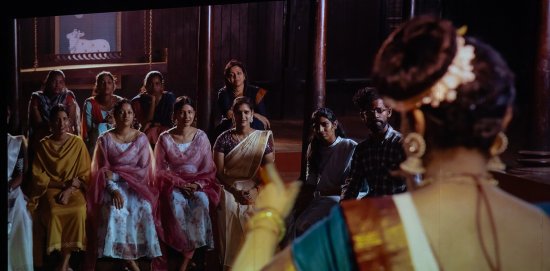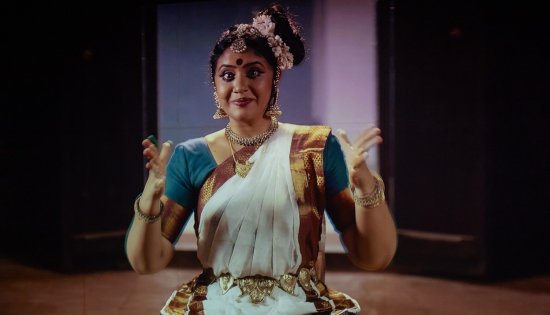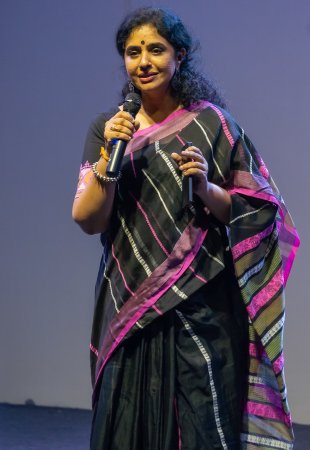
|   |

|   |
Inspiring inclusion in classical dance - Hareesh N. Nampoothiri e-mail: newn.haree@gmail.com Photos: Haree Fotografie March 21, 2024 Inclusivity is frequently discussed, with even this year's Women's Day theme centered on 'Inspiring Inclusion.' Yet, how effectively is this put into practice in real life? When it comes to classical dance, it's a visual language intimately intertwined with live music on stage. But what about those in the audience who can't hear the rhythm of the mridangam or the sung compositions? How do they perceive the dance forms, and what meaning can they extract from it? 'The Crossover,' a docu-film or a dance video documentation, conceived and executed by Mohiniyattam exponent Methil Devika, delves into these questions, exploring the intersection of classical dance with inclusivity. The film premiered at 'Ganesham', Soorya India's black-box theater, on March 10, 2024. The core idea is both simple and profound: the dancer presents her performance before an audience with hearing and speech impairments, using Indian Sign Language (ISL) to convey the context and content beforehand. Also, Devika incorporates some of their signs into the presentation, and engages with the audience afterward to know how effectively she conveyed her artistic expression. The Crossover Teaser An inclusive approach  Let's face it; many in the audience struggle to comprehend classical dance performances without the dancer explaining the content before each item. Even those who currently understand likely had a time when they required explanations or guidance. The only significant difference here is that, while the majority can typically hear and understand introductions given or lyrics, the members of the DHH community must rely solely on visual cues and ISL interpretation to grasp the performance's essence. In this context, Methil Devika introduces the idea of bridging communication with this specific audience through ISL. While classical dancers primarily use gestures as a form of expression, it doesn't necessarily facilitate communication with those who understand ISL. Additionally, classical dance narratives often deviate from spoken language, focusing more on embellishment rather than straightforward communication.  Through the live dance presentation for DHH community made into a film with audience interaction afterwards, Methil Devika proposes a symbiotic exchange. Individuals proficient in sign language can easily interpret classical dance gestures once they become acquainted with them. Conversely, classical dancers could learn ISL, utilizing sign language for item intros or even considering hiring some ISL gestures into their repertoire itself. Devika took the example of saying 'Thank you'; while 'Hastalakshanadeepika' may not have a standard hasta for that, ISL has. In her dance performance for 'The Crossover', she presented the familiar narrative of Krishna's birth through a self-composed rendition of the traditional 'Bramaniammapattu'. Incorporating elements of both Mohiniyattam and Indian Sign Language (ISL), she seamlessly blended standard gestures. For instance, when the narrative mentioned the father and mother repeatedly, she used signs from both streams alternatively. A thoughtful making  Following the screening at Soorya, Methil Devika stressed that the intention is not to advocate for Indian Sign Language (ISL) or make a paradigm shift in classical dance, Mohiniyattam here in this case, towards its incorporation. Rather, it is a notion to be pondered upon, and the docu-film proposes ways or shares ideas to foster inclusivity in performances. Addressing accessibility challenges involves not only constructing ramps for venue access but also ensuring the content presented on stage is accessible. Devika installs a communication ramp for them to reach the artiste on stage and for the performers to connect with the seated audience, thus facilitating the crossover. Methil Devika, with the assistance of Rajesh Kadamba, explores a visual crossover as well in this dance documentary. In the concluding scene where Vasudeva carries Krishna through unlocked doors, the dancer metaphorically steps out of the performance space, immersing into darkness, enhanced by thunder and lightning effects. While some may perceive this as gimmicky, in this context, it exemplified the notion of stepping beyond conventional boundaries. More or less, it all goes to individual sensitivities. Vipin Chandran handled the cinematography, while editing was overseen by Alby Natraj. Additionally, Devika received invaluable support from 'Dream of Us', an NGO based in Kozhikode, Kerala, dedicated to assisting the differently-abled community.  Dr. Hareesh N. Nampoothiri is a visual design consultant by profession, an art lover by obsession and an author, writer, photographer, editor, lyricist, and director by passion. He is also the founder and chief editor of Artograph, a bimonthly e-magazine on arts. |